2. 中国地震局地球物理研究所, 北京 100081;
3. 四川省地震局, 成都 610041
2. Institute of Geophysics, China Earthquake Administration, Beijing 100081, China;
3. Earthquake Administration of Sichuan Province, Chengdu 610041, China
地壳中广泛地存在着各向异性介质[1-2].介质的各向异性特征与地壳运动特征密切相关, 并受到地质结构、岩相、断裂分布和应力环境等因素的影响[3-5].剪切波分裂是研究地下各向异性介质特性的有效手段, 快剪切波的偏振方向反映了地震台站下方地壳的原地主压应力的方向[6], 慢剪切波的时间延迟可用于解析应力积累和应力释放[7-8].研究表明, 复杂地质结构会造成剪切波偏振方向的不同[4, 9-3]; 慢剪切波的时间延迟能反映介质的各向异性程度, 与应力的变化有关[7].
龙门山、鲜水河和安宁河三大主要断裂带构成“Y”字形, 将川西地区及邻区分割为川滇地块、松潘地块以及华南地块三大活动块体[14], 这三个块体位于青藏高原的东部, 该区域的下方是青藏高原壳幔物质由东转向东南方向运移的重要通道, 内部壳幔变形可能存在垂直连贯变形特征[15], 地壳变形强烈, 地震活动频繁.区域内5级以上地震的震源破裂图像和地震活动迁移均显示出复杂的特征[16].研究表明, 受到青藏高原的东西拉张作用, 及鲜水河、安宁河等活动断裂的控制, 川西内部的各块体受力状态不同, 区域内的主压应力场比较复杂, 不同区域之间存在着明显差异[17], 川西地区内部变形表现出明显的局部化构造特征[14], 复杂的构造环境导致了川西地区的应力局部化[18].
本研究利用剪切波分裂分析松潘-甘孜地块东部、川滇地块北部以及四川盆地西部的地壳各向异性及空间分布, 进而对区域各向异性特征与构造之间的关联, 以及青藏高原东缘和东南缘的地壳介质应力应变特性进行探讨.
2 背景松潘-甘孜地块由多条断层及强烈的构造变形带组成, 断裂的活动表现出明显的不均匀性与分段活动特征[19].其东边界为北东走向的龙门山断裂带(图 1), 龙门山断裂带吸收了青藏高原与华南块体之间的地壳缩短[20], 也因此孕育了2008年5月l2日汶川Ms8.0级地震.其北边界为鲜水河断裂带(图 1), 该断裂带是中国大陆内部活动最剧烈的断裂带之一.松潘-甘孜地块东部地区的主压应力主轴的优势方向为北东东向或者近东西向[21].由近南北向安宁河断裂带、则木河断裂带构成的川滇地块东界[22-23], 在不同断裂带及同一断裂带的不同地区的应力积累水平的空间差异较大[24], 在川滇菱形地块内部, 主压应力场表现出北部为近东西向的、南部为近南北方向的分区特性[25-26].四川盆地位于龙门山断裂带东部, 属稳定华南地块(图 1), 其主压应力优势方向为北西西向[21, 27-28].在研究区中部, 受到复杂结构的影响, 龙门山断裂带、鲜水河断裂带和安宁河断裂带的交汇地区的主压应力方向表现出复杂的特点[29].
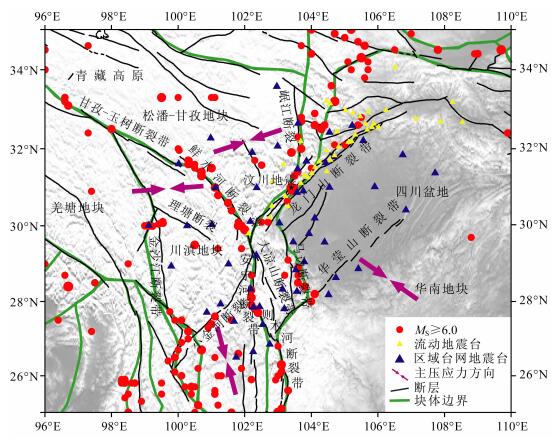
|
图 1 四川区域台网地震台站分布, 川西地区内的断裂与地震活动分布.松潘-甘孜地块东部、川滇地块及四川盆地以及区域主压应力分布 红色圆点表示中国大陆有史料记载(公元前780年-2011年12月)以来发生的地震, 震级Ms≥6.0级地震[30-31]. Fig. 1 The distribution of seismic stations of Sichuan Regional Seismograph Network, seismic activity and principal compressive stress in east of Songpan-Garze block, the Sichuan-Yunnan style="border-bottom:1px solid; "ock and the Sichuan Basin The red dots indicate the historical earthquakes from historical recordswith Ms≥6.0 inChina ("Historical Earthquake Catalog in China"and "The Modern Historical Earthquake Catalog inChina")[30-31]. |
剪切波分裂是研究地壳介质的各向异性特征的有效手段之一[4, 32-37].本研究使用剪切波分裂系统分析法-SAM方法[38-39], 该方法是在相关函数的基础上提出的一种自我检验的分析方法, 包括相关函数计算、时间延迟校正和偏振分析检验.该方法得到的结果的稳定性和可靠性比较强.
研究使用四川区域数字地震台网资料分析研究区的地震各向异性特征.四川数字地震台网从2000年开始运行, 由“九五”数字地震台网的19个数字地震台, 扩建到2007年“十五”数字地震台网的52个地震台[40].“九五”数字地震台网中包括6个宽频带地震台和13个短周期地震台, 其中宽频带地震仪在0.05~40 Hz范围, 短周期地震仪在1~20 Hz;十五”数字地震台网的地震仪的频带宽度为120 s~20 Hz本研究使用2007年1月-2010年4月期间四川区域地震台网记录到的区域地震资料, 根据四川地区速度结构[41]以及龙门山地区的速度结构[42], 挑出四川地震台网中每个台站记录的“剪切波窗口”内的地震事件波形, 并在此基础上挑选波形质量较高可用于剪切波分裂分析的波形, 称之为有效波形记录.图 2和图 3显示了两个不同地震台站得到的有效波形记录和使用SAM方法计算得到剪切波分裂的实例.

|
图 2 QCH台记录的数据(20080904133730)进行的剪切波分裂分析(SAM)过程 上图分别为垂直、东西和南北向的地震波形;左下图显示为南北(NS)和东西(EW)方向分量的剪切波的质点运动轨迹图以及剪切波波形, 图中S1和S2分别表示快剪切波和慢剪切波的到时.右下图显示已消除了时间延迟的影响后快(F)和慢(S)剪切波的质点运动轨迹图以及快慢剪切波的波形, 其中横坐标表示采样点的个数, 纵坐标表示振幅comt值, 图中的竖线表示用来做质点运动轨迹的剪切波部分.两条竖线表示出用于做剪切波分裂的波形. Fig. 2 Shear-wave splitting analysis of seismic wave (20080904133730) recorded by station QCH The upper is original waveform with vertical, north-south and east-west direction.The lower-lett is the trail of particle movement of original shear-wave and waveforms at north-south (NS) and east-west (EW) direction.The S1 and S2 respectively indicate the start position of fast shear-wave and slow shear-wave.The lower-right is fast shear-wave(F) and slow shear-wave (S) and the trail of particle movement of fast shear-wave and slow shear-wave, which have eliminated the effect of time delay.The ordinate is the count value of amplitude.Theabscissa isthe numberof sampling points.Two erected lines pointout thesegmentof shear waveform showed in polarization diagram. |
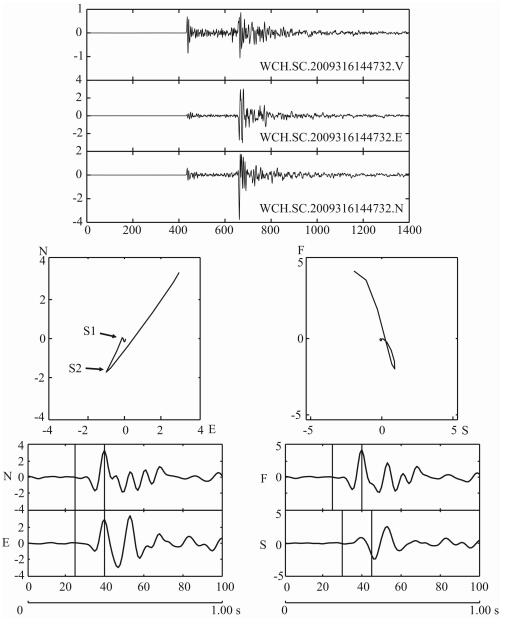
|
图 3 WCH台记录的数据(2009316144732)进行剪切波分裂分析(SAM)过程 其它含义同图 3. Fig. 3 Shear-wave splitting analysis (SAM)of seismic wave (2009316144732) recorded by WCH station Other meaning is the same as in Fig. 3. |
本研究在获得2007年1月-2010年4月期间四川区域地震台网的31台站下方的地震各向异性参数的基础上, 结合了2000-2006年的“九五”地震台网的波形资料得到的各向异性的研究结果[43]和汶川地震余震序列的波形资料得到的龙门山地区地震各向异性结果[44].为了保证结果的可靠性, 研究采用“剪切波窗口”内有效波形记录大于3条的台站.本研究从2000年1月-2010年4月期间记录的区域地震波形中, 获得31个区域地震台站下方的地震各向异性参数(表 1); 以及在汶川地震后, 架设的流动地震台中的13个台站下方的地震各向异性参数[44], 共得到44个台站的结果.
根据各个台站的等面积投影玫瑰图(图 4)显示, 大部分台站快剪切波的优势偏振方向的一致性较好, 例如PWU(平武)台和WCH(汶川)台.位于活动断裂周围的台站的快剪切波的偏振方向和断裂走向一致, 例如位于鲜水河断裂上的DFU(道孚)台, 以及MXI(茂县)台.这个现象显示出活动的走滑断裂的作用, 造成断裂带上及附近地区地震台站的快剪切波偏振方向与断裂的走向一致.然而, 也有位于活动断裂上的台站, 其快剪切波的偏振方向和断裂走向垂直, 例如QCH(青川)台.个别台站表现出了复杂的优势偏振方向, 例如位于鲜水河断裂带、龙门山断裂带和安宁河断裂带交汇处的GZA(姑咱)台.
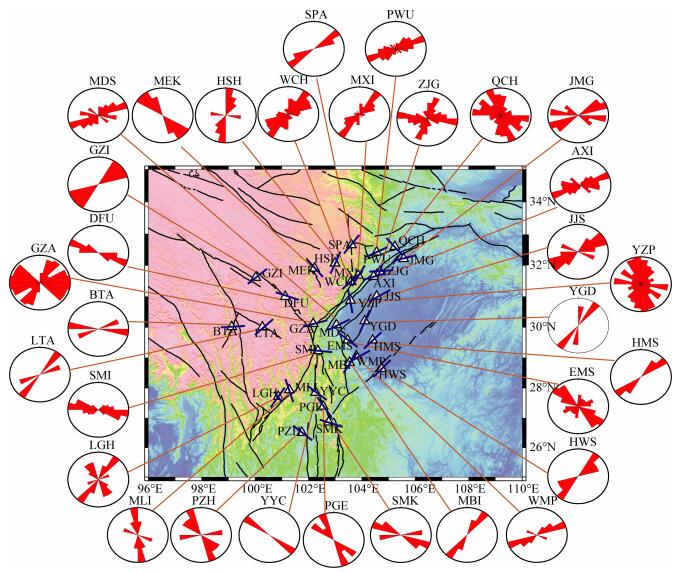
|
图 4 松潘-甘孜地块东部、川滇地块及四川盆地内台站的快剪切波偏振方向的等面积投影玫瑰图 蓝色线条表示各个台站下方的平均快剪切波偏振方向, 黑框白三角表示四川区域台网地震台. Fig. 4 The homolographic projection rose graphs of each seismic stations in the east of Songpan-Garze block, the Sichuan-Yunnan block and the Sichuan Basin The blue lines indicate the average fast shear-wave polarization beneath each station The black box white triangle indicates the seismic stations of Sichuan Regional Seismograph Network. |
阚荣举等[27]根据震源机制解的统计结果得到, 鲜水河断裂带及其以东地区以及龙门山断裂以北地区(松潘-甘孜块体)的主压应力方向为北东一北东东向.本研究有三个地震台位于此区域中(SPA, HSH和MEK), 其中SPA(松潘)台下方的快剪切波的偏振方向为北东东向.松潘、平武地区现代构造应力场主压应力主要有两组优势方向, 分别为南东东向和北东东向[45], 研究得到的北东东向和该区域的主压应力方向一致, HSH(黑山)台和SPA台表现出了类似的快剪切波偏振方向.MEK(马尔康)台位于马尔康断裂松岗段, 根据小金6.6级地震序列震源机制的结果显示, 该断裂主压应力与区域应力场一致[46].本研究得到, MEK (马尔康)台的快剪切波偏振的优势方向为北西向, 与马尔康断裂松岗段的主压应力方向一致, 与GPS主压应变方向[47-48]一致, 并与马尔康断裂走向一致.
根据晚第四纪活动性分段的初步研究, 龙门山断裂带西南段和北东段的活动性以及活动方式存在明显差异[49-50].在石玉涛等[44]对2008年汶川地震余震的各向异性特征研究结果基础上, 本研究使用更多资料分析了位于龙门山断裂带上台站下方的快剪切波偏振方向.结果显示, 位于其北东段上多数台站下方的快剪切波的偏振方向为北东向, 与断裂带走向一致, 位于西南段上多数台站下方的快剪切波的偏振方向为北西向, 与断裂带走向垂直(图 4、图 6).这个结果, 也印证了龙门山断裂的西南段和北东段表现出来的不同震源机制的形式[51].研究显示AXI(安县)台以北地震台的快剪切波偏振方向整体显示为近北东东向(图 4), 具有较好的一致性, 并与龙门山断裂带的走向一致.
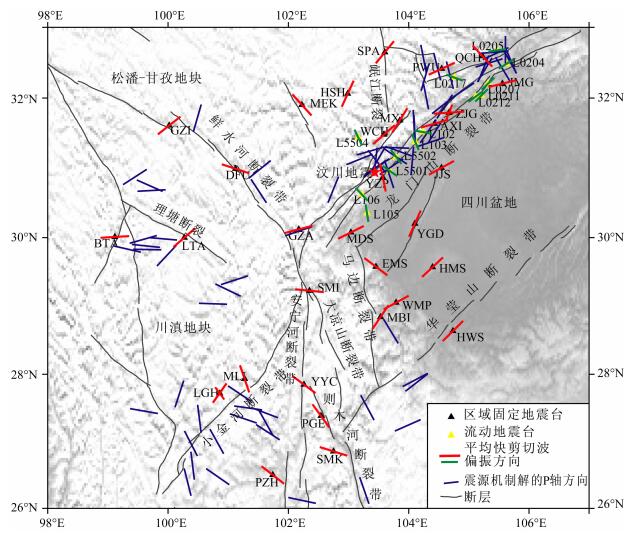
|
图 6 松潘-甘孜地块东部、川滇地块及四川盆地内台站的快剪切波平均偏振方向的空间分布图 红色和绿色线条分别表示区域固定地震台站和流动地震台下方的平均快剪切波偏振方向, 黑色三角表示四川区域台网地震台.蓝色线段表示自1970年1月至2010年7月期间四川地区中强地震的震源机制的最大主压应力方向, 此结果来自哈佛大学. Fig. 6 The average fast shear-wave polarization beneath the east of Songpan-Garze block, the Sichuan-Yunnan block and Sichuan Basin The red and green lines respectively show the average fast shear-wave polarization of stations of Sichuan Regional Seismograph Network and mobile seismic stations.The black triangles indicate seismic stations of the Sichuan Regional Seismograph Network. The blue lines show the directions of maximum principal compressive stress axis of focal mechanism from Harvard University during January 1970 to July 2010. |
QCH台的快剪切波的偏振方向与周边台站的快剪切波偏振方向有所不同, 主要表现为近东西向和近南北向(图 5), 其近东西向与当地区域主压应力方向和断裂的走向有一致性, 而近南北向与龙门山断裂带的走向斜交.根据QCH台得到剪切波分裂参数按震源位置显示的空间分布特征, 可以看出, 以青川断裂为界(龙门山断裂带的后山断裂), 来自青川断裂北侧地震的快剪切波偏振方向以近南北向为主, 而来自青川断裂南侧的地震的快剪切波偏振方向以近东西向为主; 从时间延迟分布特征上看, 青川断裂北侧地震的慢剪切波的时间延迟总体上大于该断裂南侧地震的慢剪切波时间延迟(图 5), 北侧和南侧地震得到的慢剪切波的平均时间延迟分别为1.72±1.04 ms/km和0.98±0.74 ms/km.青川断裂位于龙门山东段, 其周边地震的震源机制表现出明显的不同, 既有走滑型地震, 也有逆冲型地震[52].研究认为, 在复杂的构造应力影响下, 断层两侧地震得到的快剪切波分裂参数表现为不同特征.
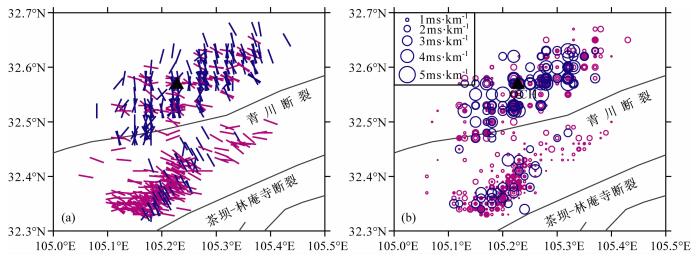
|
图 5 QCH台记录到的各个地震的快剪切波偏振方向(a)以及时间延迟分布(b) 图中短线表示各个地震快剪切波方向, 其中蓝色表示近南北方向, 紫色表示近东西方向.(b)图的圆圈大小表示慢剪切波的时间延迟, 其中蓝色圆圈表示时间延迟大于2 ms/km, 紫色圆圈表示时间延迟小于2 ms/km. Fig. 5 The distribution of fast shear-wave polarization (a) and the time-delay slow shear-wave (b) beneath QCH station The short lines in (a) are direction of fastshear-wave polarizations, where the blue lines are nearly north-south direction, and purple lines are nearly east-west direction.The circle in(b) is the time delay of slow shear-wave, where the blue circle indicates the time delay is greater than 2 ms/km, and the purple circle indicates the time delay is less than 2 ms/km. |
AXI台以南的流动地震台(L102、L103、L5502、L5501、L105、L106)的快剪切波偏振方向整体显示为近北西向, 区域台网(WCH、MXI)下方的快剪切波的偏振方向显示为北东向(图 6).石玉涛等[44]利用汶川地震后三个月的余震序列得到MXI台快剪切波的偏振方向为北北西向, 这个不同, 可能正好说
明了汶川地震发生后造成破裂带及邻近地区的地壳介质和应力的改变, 造成观测结果的不同.WCH台和MXI台位于茂县一汶川断裂上, 地质调查表明, 龙门山断裂带后山断裂的茂县一汶川断裂以左旋走滑运动为主, 而主要推覆构造为其东部的北川一映秀断裂和灌县一江油断裂[53].在茂县一汶川断裂附近的地震震源机制也存在走滑运动为主的地震[51-52].受到汶川一茂汶断裂走滑构造影响, MXI台和WCH台下方的快剪切波优势偏振方向表现为北东向, 与断裂的走向一致.
川滇菱形地块是在印度板块北移、青藏高原东侧物质南东向侧移以及华南块体强烈阻挡的共同作用下形成, 其构造边界带作为应力转换带, 造成研究区的应力场局部变化特征.川滇菱形块体西北部和东南部主压应力方向分别为北西西向和北北西向[26].小金河断裂是川滇菱形地块内一条横向逆走滑活动断裂, 将川滇菱形地块分为西北部和东南部.川滇菱形地块西北部的震源机制解反映区域构造应
力方向的最大主压应力方向为北西向及近东西向(图 6)[28, 54].本研究得到的GZI(甘孜)台、DFU台、LTA(理塘)台及BTA(巴塘)台地震台的快剪切波的偏振方向与台站周围震源机制解揭示的区域构造应力的最大主压应力方向比较一致(图 6).DFU台位于鲜水河断裂带上, 受到断裂的影响, 快剪切波偏振方向与断裂的走向比较一致;GZI台位于鲜水河断裂带和甘孜一玉树断裂带的交汇处, 此地区属正在发展的拉分盆地, 主要作用是将其南北两侧的断块水平剪切运动转换成为局部挤压抬升及逆断层运动, 因此也导致该地区曾发生正断层型的强震[55].研究得到鲜水河断裂带和甘孜一玉树断裂带上地震的震源机制解的P轴空间分布自北向南呈现出北东向到北东东向渐变特征[25].本研究得到GZI台的快剪切波偏振方向为北东向, 与断裂的走向斜交, 也反映出该地区的复杂的构造状态.LTA台及BTA台与快剪切波偏振方向基本与其周围地震的震源机制P轴方向较一致(图 6).在小金河断裂附近的LGH(泸沽湖)台和MLI(木里)台站下方的快剪切波优势偏振方向为近北西向, 与该地区区域主压应力方向一致[26-27], 而LGH台更明显的近北东向优势方向的快剪切波偏振显示了该地区局部构造的复杂, 这种影响可能与北东走向的小金河断裂带有关.研究认为, 受到小金河逆推断裂构造带的屏蔽作用, 川滇菱形地块内中上地壳物质的南向运动在经过小金河断裂构造带时明显衰减, 其西北部的地壳明显增厚[56-57].LGH(泸沽湖)台和MLI(木里)台站下方的快剪切波优势偏振方向验证了受到青藏高原的作用川滇菱形地块的主压应力方向为近北西向, 但是受到小金河断裂的横向构造的阻挡、屏蔽造成了川滇菱形地块的西北部地壳增厚, 并在小金河断裂附近显示出较为复杂的应力特征.
鲜水河断裂带、龙门山断裂带与安宁河断裂带交汇处的地质结构复杂, 利用震源机制解得到龙门山断裂南端东西侧, 以及安宁河断裂带北部周边地区的地震的震源机制P轴为近东西方向[29, 58], 这个结果和本研究得到位于该交汇处的台站GZA台、MDS(蒙顶山)台和SMI(石棉)台的快剪切波偏振方向为近似北东东向的结果一致(图 6, 图 7).
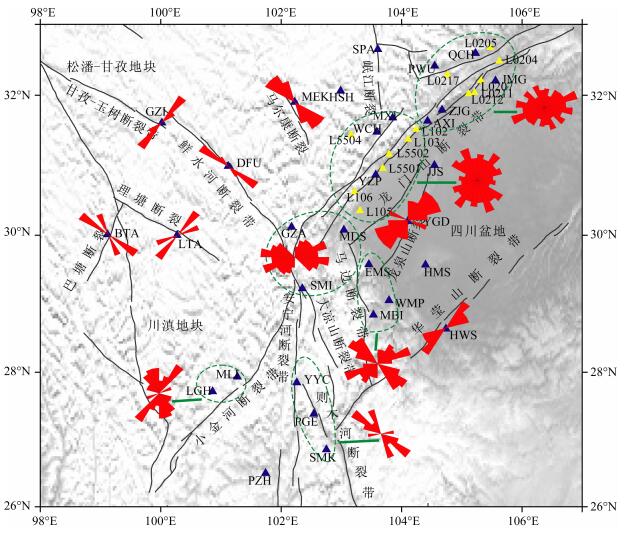
|
图 7 松潘-甘孜地块东部、川滇地块及四川盆地内台站的快剪切波偏振方向的等面积投影玫瑰图 蓝色三角和黄色三角分别表示研究使用的区域地震台和流动地震台.绿色虚线内的台站表示同一个断裂周边的台站, 根据这些台站下方的数据获得该断裂带上快剪切波偏振方向的等面积投影玫瑰图.仅有一个台站的断裂, 其快剪切波偏振方向的等面积投影玫瑰图用该台站下方的数据结果表示. Fig. 7 The homolographic projection rose graph in the east of Songpan-Garzê block, the Sichuan-Yunnan block and the Sichuan Basin stations The blue and yellow triangles respectively indicate the seismic stations, which were used in the study. The homolographic projection rose graphs are acquired by stations within the green dotted line, which located the same faults. Thehomolographic projection rose graphs are acquired by station, which solely located fault. |
根据研究区域44个台站(包括“九五”地震台网和汶川地震余震序列资料)共3129条有效记录的剪切波分裂参数结果, 按照构造情况进行分区, 得到不同构造下方快剪切波偏振方向等面积投影玫瑰图(图 7).几个分区的快剪切波优势偏振方向和几个位于特别构造地区的单台站快剪切波优势偏振方向特征显示(图 7), 快剪切波偏振方向受到区域主压应力和断层构造的影响.受到活动断裂构造的影响, 部分地区的快剪切波的偏振方向与断层走向一致, 例如马尔康断裂上的MEK台, 以及位于则木河断裂上的YYC(园艺场)、PGE(普格)和SMK(石门坎)台.然而, 部分位于断层周边的台站受到区域构造应力的影响, 其快剪切波的偏振方向与断层的走向斜交, 与区域主压应力方向一致, 例如位于小金河断裂的LGH台和MLI台.
在区域主压应力的作用下, 岩石中裂隙的定向排列形成了地壳介质的地震各向异性, 通过快剪切波的偏振方向可以获得岩石裂隙的平均方向以及区域主压应力方向[1].震源机制解虽可以反映出地壳内部震源区发震断层附近的应力状态, 但其P轴并不等同于构造应力场的主压应力轴.因而, 震源机制解很难反映出整体的构造区的构造应力环境[59].利用GPS观测结果得到的块体运动方向, 采用稳定点作为基准, 获得相对位移速率, 反映地壳当前变形特征, 获得的应变方向为应变增量的方向[60].因而, 尽管利用剪切波分裂、震源机制以及GPS应变方向都可以获得主压应力方向, 但是描述的区域主压应力场的特征有所不同.
本研究得到研究区内各个台站的慢剪切波时间延迟(图 8, 表 1).多数的研究台站位于龙门山断裂带上, 其下方的慢剪切波的平均时间延迟为2.12 ms/km.位于龙门山断裂带北段的多数台站下方时间延迟偏小, 例如PWU台和QCH台的时间延迟分别为0.83±0.65 ms/km和1.35±1.00 ms/km; 位于龙门山断裂带南段的多数台站下方慢剪切波时间延迟较大, 其中位于汶川地震震源区的YZP (油榨坪)台, 其下方的慢剪切波的时间延迟为2.45±1.34 ms/km.作为龙门山断裂构造的转换边界, AXI台和ZJG(江油)台下方的慢剪切波的时间延迟较大.川滇地块内部台站下方的时间延迟相对较高, 例如GZI台和MLI台的时间延迟分别为2.48±0.99 ms/km和2.86±1.54 ms/km, 川滇菱形地块北部的平均慢剪切波时间延迟为2.41±1.36 ms/km.在龙门山断裂带、鲜水河断裂带和安宁河断裂带的交汇地区台站下方的慢剪切波的时间延迟较小, 例如MDS台, GZA台以及SMI台的慢剪切波的时间延迟分别为2.05±1.31 ms/km, 1.30±0.87 ms/km和1.18±1.26 ms/km.研究认为, 台站下方的慢剪切波的时间延迟受到断层分布及几何形态控制, 导致慢剪切波时间延迟较小.四川盆地内部得到有效波形数据的台站较少, 因此需要更多资料来支持四川盆地内台站下方的慢剪切波的时间延迟特征.
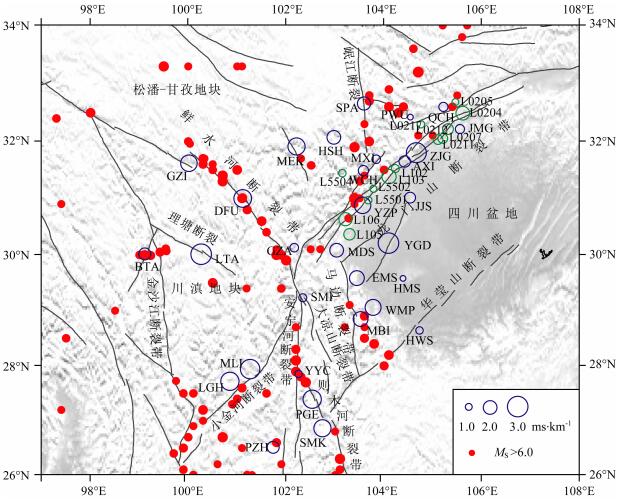
|
图 8 松潘-甘孜地块东部、川滇地块及四川盆地西部台站下方的平均慢剪切波时间延迟分布 蓝色圆圈为区域固定地震台得到的结果, 绿色圆圈为流动地震台得到的结果.红色圆点为中国大陆有史以来历史地震分布图(同图 1). Fig. 8 Thedistribution of time-delay of slow shear-wave in the east Songpan-Garzê block, Sichuan-Yunnan block and the Sichuan Basin The blue and green circles respectively indicate the time-delays of stations of Sichuan Regional Seismograph Network and mobile seismic stations. The red dots indicate the historical earthquakes in China (other meaning are same as Fig.1). |
|
|
表 1 研究区内台站下方地壳剪切波分裂结果 Table 1 The results of shear-wave splitting beneath the research area |
本研究利用了松潘-甘孜地块东部、川滇地块及四川盆地内44个台站2000年1月-2010年4月期间记录的资料, 得到该地区的快剪切波偏振方向和慢剪切波的时间延迟的空间分布特征.结果显示, 以安县为界, 龙门山断裂带分为北东段和西南段, 北东段的快剪切波的偏振方向为北东向, 与断裂带走向基本一致; 西南段的快剪切波的优势偏振方向为北西向, 与断裂带走向斜交, 考虑到剔除相对远离龙门山断裂带的几个台站, 则快剪切波优势偏振方向几乎与断裂带走向正交.以小金河断裂为界, 川滇菱形地块分为西北部和东南部, 西北部的快剪切波的偏振方向为近东西向, 东南部的快剪切波偏振方向为北北西向.从时间延迟分布上看, 龙门山断裂带北东段的慢剪切波的时间延迟总体上小于西南段; 在川滇菱形地块中, 其内部台站较周边块体内的台站下方的时间延迟大.在龙门山断裂带、鲜水河断裂带和安宁河断裂带交汇处, 快剪切波的偏振方向表现为近东西向, 区域内各台站的时间延迟较小.研究证实, 快剪切波的偏振方向受到区域主压应力场以及局部地质结构的影响, 在活动性较强的有走滑性质的断裂上及近邻, 快剪切波的偏振方向与断裂的走向趋于一致, 例如位于鲜水河断裂上的台站, 其快剪切波的偏振方向与断裂的走向一致.然而, 在构造活动比较强烈的块体, 例如川滇菱形块体内部, 快剪切波的偏振方向与区域主压应力方向一致.在构造较为复杂的青川断裂上, 来自青川断裂南北两侧的地震显示出剪切波分裂参数的不同特征.青川断裂北侧和南侧地震的快剪切波的偏振方向分别为近南北向和近东西向, 同时, 断裂北侧地震的慢剪切波的时间延迟大于该断裂南侧地震的慢剪切波时间延迟, 进一步显示出剪切波分裂参数的局域化特征.本研究表明, 在构造变形强烈且极为复杂的南北地震带中南段, 地壳剪切波分裂显示了与构造和应力密切相关的分布特征.
致谢感谢中国地震局地球物理研究所“国家数字测震台网数据备份中心”和四川省地震局为本研究提供了地震波形数据.感谢郑秀芬研究员在资料的收集、处理过程中提供的帮助.
| [1] | Crampin S. Seismic-wave propagation through a cracked solid:polarization as a possible dilatancy diagnostic. Geophys. J. Rastron Soc , 1978, 53(3): 467-496. DOI:10.1111/gji.1978.53.issue-3 |
| [2] | Zhang Z J, Li Y K, Lu D Y, et al. Velocity and anisotropy structure of the crust in the Dabieshan orogenic belt from wide-angle seismic data. Phys. Earth. Planet. Inter , 2000, 122(1-2): 115-131. DOI:10.1016/S0031-9201(00)00190-4 |
| [3] | Crampin S, Peacock S. A review of the current understanding of seismic shear-wave splitting in the Earth's crust and common fallacies in interpretation. Wave Motion , 2008, 45(6): 675-722. DOI:10.1016/j.wavemoti.2008.01.003 |
| [4] | Gao Y, Wu J, Fukao Y, et al. Shear wave splitting in the crust in North China:stress, faults and tectonic implications. Geophys. J. Int , 2011, 187(2): 642-654. DOI:10.1111/j.1365-246X.2011.05200.x |
| [5] | Zhang Z, Teng J, Badal J, et al. Construction of regional and local seismic anisotropic structures from wide-angle seismic data:crustal deformation in the southeast of China. J. Seismol , 2009, 13(2): 241-252. DOI:10.1007/s10950-008-9124-0 |
| [6] | Crampin S. Effective anisotropic elastic constants for wave propagation through cracked solids. Geophys. J. Rastron Soc , 1984, 76(1): 135-145. DOI:10.1111/j.1365-246X.1984.tb05029.x |
| [7] | Gao Y, Crampin S. Observations of stress relaxation before earthquakes. Geophys. J. Int , 2004, 157(2): 578-582. DOI:10.1111/gji.2004.157.issue-2 |
| [8] | Gao Y, Crampin S. A further stress-forecast earthquake (with hindsight), where migration of source earthquakes causes anomalies in shear-wave polarizations. Tectonophysics , 2006, 426(3-4): 253-262. DOI:10.1016/j.tecto.2006.07.013 |
| [9] | 高原, 郑斯华, 孙勇. 唐山地区地壳裂隙各向异性. 地震学报 , 1995, 17(3): 283–293. Gao Y, Zheng S H, Sun Y. Crustal crack anisotropy in Tangshan. Acta Seismologica Sinica (in Chinese) , 1995, 17(3): 283-293. |
| [10] | 高原, 郑斯华, 周蕙兰. 唐山地区快剪切波偏振图像及其变化. 地球物理学报 , 1999, 42(2): 228–232. Gao Y, Zheng S H, Zhou H L. Polarization patterns of fast shear wave in Tangshan region and their variations. Chinese J. Geophys (in Chinese) , 1999, 42(2): 228-232. |
| [11] | 雷军, 王培德, 姚陈, 等. 云南剑川近场横波特征及其与构造的关系. 地球物理学报 , 1997, 40(6): 791–801. Lei J, Wang P D, Yao C, et al. The near-field shear wave splitting and its relation with structure in Jianchuan, Yunnan Province. Chinese J. Geophys (in Chinese) , 1997, 40(6): 791-801. |
| [12] | Shi Y T, Gao Y, Wu J, et al. Crustal seismic anisotropy in Yunnan, Southwestern China. J. Seismol , 2009, 13(2): 287-299. DOI:10.1007/s10950-008-9128-9 |
| [13] | Wu J, Gao Y, Chen Y T. Shear-wave splitting in the crust beneath the southeast Capital area of North China. J. Seismol , 2009, 13(2): 277-286. DOI:10.1007/s10950-008-9127-x |
| [14] | 张培震. 青藏高原东缘川西地区的现今构造变形、应变分配与深部动力过程. 中国科学(D辑:地球科学) , 2008, 38(9): 1041–1056. Zhang P Z. Present-day tectonic deformation, strain partitioning and deep dynamics in the western Sichuan, eastern Tibetan Plateau. Science in China (Series D) (in Chinese) , 2008, 38(9): 1041-1056. |
| [15] | 常利军, 王椿镛, 丁志峰. 四川及邻区上地幔各向异性研究. 中国科学(D辑:地球科学) , 2008, 51(12): 1683–1693. Chang L J, Wang C Y, Ding Z F. Seismic anisotropy of upper mantle in Sichuan and adjacent regions. Science in China (Series D) (in Chinese) , 2008, 51(12): 1683-1693. DOI:10.1007/s11430-008-0147-8 |
| [16] | Gao Y, Wu Z L, Liu Z, et al. Seismic source characteristics of nine strong earthquakes from 1988 to 1990 and earthquake activity since 1970 in the Sichuan-Qinghai-Xizang (Tibet) zone of China. Pure Appl. Geophys , 2000, 157(9): 1423-1443. DOI:10.1007/PL00001127 |
| [17] | 谢富仁, 崔效锋, 赵建涛, 等. 中国大陆及邻区现代构造应力场分区. 地球物理学报 , 2004, 47(4): 654–662. Xie F R, Cui X F, Zhao J T, et al. Regional division of the recent tectonic stress field in China and adjacent areas. Chinese J. Geophys (in Chinese) , 2004, 47(4): 654-662. |
| [18] | 王辉, 刘杰, 申旭辉, 等. 断层分布及几何形态对川西及邻区应变分配的影响. 中国科学D辑:地球科学 , 2010, 53(7): 1056–1070. Wang H, Liu J, Shen X H, et al. Influence of fault geometry and fault interaction on strain partitioning within western Sichuan and its adjacent region. Science in China (Series D) (in Chinese) , 2010, 53(7): 1056-1070. DOI:10.1007/s11430-010-0062-7 |
| [19] | 唐荣昌, 文德华, 黄祖智, 等. 松潘-龙门山地区主要活动断裂带第四纪活动特征. 中国地震 , 1991, 7(3): 64–71. Tang R C, Wen D H, Huang Z Z, et al. The Quaternary activity characteristics of several major active faults in the Songpan-Longmenshan Region. Earthquake Research in China (in Chinese) , 1991, 7(3): 64-71. |
| [20] | Allen C R, Luo Z, Qian H, et al. Field study of a highly active fault zone:The Xianshuihe fault of southwestern China. Geol. Soc. Am. Bull , 1991, 103(9): 1178-1199. DOI:10.1130/0016-7606(1991)103<1178:FSOAHA>2.3.CO;2 |
| [21] | 程万正, 刁桂苓, 吕弋培, 等. 川滇地块的震源力学机制、运动速率和活动方式. 地震地质 , 2003, 25(1): 71–87. Cheng W Z, Diao G L, Ü Y P, et al. Focal mechanisms, displacement rate and mode of motion of the Sichuan-Yunnan block. Seismology and Geology (in Chinese) , 2003, 25(1): 71-87. |
| [22] | 张培震, 邓起东, 张国民, 等. 中国大陆的强震活动与活动地块. 中国科学(D辑:地球科学) , 2003, 46(Suppl.2): 13–24. Zhang P Z, Deng Q D, Zhang G M, et al. Active tectonic blocks and strong earthquakes in the continent of China. Science in China (Series D) (in Chinese) , 2003, 46(Suppl.2): 13-24. |
| [23] | 徐锡伟, 闻学泽, 郑荣章, 等. 川滇地区活动块体最新构造变动样式及其动力来源. 中国科学(D辑:地球科学) , 2003, 46(Suppl. 2): 210–226. Xu X W, Wen X Z, Zheng R Z, et al. Pattern of latest tectonic motion and its dynamics for active blocks in Sichuan-Yunnan region, China. Science in China (Series D) (in Chinese) , 2003, 46(Suppl. 2): 210-226. |
| [24] | 易桂喜, 闻学泽, 苏有锦. 川滇活动地块东边界强震危险性研究. 地球物理学报 , 2008, 51(6): 1719–1725. Yi G X, Wen X Z, Su Y J. Study on the potential strong earthquake risk for the eastern boundary of the Sichuan-Yunnan active faulted-block, China. Chinese J. Geophys (in Chinese) , 2008, 51(6): 1719-1725. |
| [25] | 刘平江, 刁桂苓, 宁杰远. 川滇地块的震源机制解特征及其地球动力学解释. 地震学报 , 2007, 29(5): 449–458. Liu P J, Diao G L, Ning J Y. Fault plane solutions in Sichuan-Yunnan rhombic block and their dynamic implications. Acta Seismologica Sinica (in Chinese) , 2007, 29(5): 449-458. |
| [26] | 崔效锋, 谢富仁, 张红艳. 川滇地区现代构造应力场分区及动力学意义. 地震学报 , 2006, 28(5): 45l–46l. Cui X F, Xie F R, Zhang H Y. Recent tectonic stress field zoning in Sichuan-Yunnan region and its dynamic interest. Acta Seismologica Sinica (in Chinese) , 2006, 28(5): 45l-46l. |
| [27] | 阚荣举, 张四昌, 宴风桐. 我国西南地区现代构造应力场与现代构造活动特征的探讨. 地球物理学报 , 1977, 20(2): 96–109. Kan R J, Zhang S C, Yan F T. Present tectonic stress field and its relation to the characteristics of recent tectonic activity in southwestern China. Chinese J. Geophys. (Acta Geophysica Sinica) (in Chinese) , 1977, 20(2): 96-109. |
| [28] | 蒲晓虹, 郭惠兰. 四川地区现代构造应力场的空间分布特征及潜在震源区判定. 西北地震学报 , 1993, 15(2): 97–99. Pu X H, Guo H L. The space distribution characteristics of recent tectonic stress field and earthquake risk zoning in Sichuan Region. Northwestern Seismological Journal (in Chinese) , 1993, 15(2): 97-99. |
| [29] | 龙思胜, 赵珠. 鲜水河、龙门山和安宁河三大断裂交汇地区震源应力场特征. 地震学报 , 2000, 22(5): 457–464. Long S S, Zhao Z. Characteristics of the seismic source stress field in the intersection region of Xianshuihe, Longmenshan and An'ninghe Faults. Acta Seismologica Sinica (in Chinese) , 2000, 22(5): 457-464. |
| [30] | 国家地震局震害防御司. 中国历史强震目录. 北京: 地震出版社, 1995 . Department of Earthquake Preparedness and Disaster Mitigation. The Historical Earthquake Catalog in China (in Chinese). Beijing: Seismological Press, 1995 . |
| [31] | 中国地震局震害防御司. 中国近代地震目录. 北京: 地震出版社, 1999 . Department of Earthquake Preparedness and Disaster Mitigation. The Modern Historical Earthquake Catalog in China (in Chinese). Beijing: Seismological Press, 1999 . |
| [32] | 姚陈, 王培德, 陈运泰. 卢龙地区S波偏振与上地壳裂隙各向异性. 地球物理学报 , 1992, 35(3): 305–315. Yao C, Wang P D, Chen Y T. Shear wave polarization and crack induced anisotropy of upper crust in Lulong, north China. Chinese J. Geophys. (Acta Geophysica Sinica) (in Chinese) , 1992, 35(3): 305-315. |
| [33] | Gao Y, Wang P D, Zheng S H, et al. Temporal changes in shear-wave splitting at an isolated swarm of small earthquakes in 1992 near Dongfang, Hainan Island, southern China. Geophys. J. Int , 1998, 135(1): 102-112. DOI:10.1046/j.1365-246X.1998.00606.x |
| [34] | 吴晶, 高原, 石玉涛, 等. 基于地壳介质各向异性分析江苏及邻区构造应力特征. 地球物理学报 , 2010, 53(7): 1622–1630. Wu J, Gao Y, Shi Y T, et al. Tectonic stress analysis based on the crustal seismic anisotropy in Jiangsu and its adjacent area. Chinese J.Geophys (in Chinese) , 2010, 53(7): 1622-1630. |
| [35] | 石玉涛, 高原, 吴晶, 等. 云南地区地壳介质各向异性-快剪切波偏振特性. 地震学报 , 2006, 28(6): 574–585. Shi Y T, Gao Y, Wu J, et al. Seismic anisotropy of the crust in Yunnan, China:polarizations of fast shear-waves. Acta Seismologica Sinica (in Chinese) , 2006, 28(6): 574-585. |
| [36] | 吴晶, 高原, 陈运泰, 等. 首都圈西北部地区地壳介质地震各向异性特征初步研究. 地球物理学报 , 2007, 50(1): 209–220. Wu J, Gao Y, Chen Y T, et al. Seismic anisotropy in the crust in northwestern capital area of China. Chinese J. Geophys (in Chinese) , 2007, 50(1): 209-220. |
| [37] | 郑秀芬, 陈朝辉, 张春贺. 1999年台湾集集地震余震区-嘉义地区地震的剪切波分裂参数随时间变化的研究. 地球物理学报 , 2008, 51(1): 149–157. Zheng X F, Chen C H, Zhang C H. Study on temporal variations of shear-wave splitting in the Chiayi area, aftershock zone of 1999 Chichi earthquake, Taiwan. Chinese J. Geophys (in Chinese) , 2008, 51(1): 149-157. |
| [38] | 高原, 刘希强, 梁维, 等. 剪切波分裂系统分析方法(SAM)软件系统. 中国地震 , 2004, 20(1): 101–107. Gao Y, Liu X Q, Liang W, et al. Systematic analysis method of shear-wave splitting:SAM software system. Earthquake Research in China (in Chinese) , 2004, 20(1): 101-107. |
| [39] | 高原, 石玉涛, 梁维, 等. 剪切波分裂分析系统SAM(2007)-软件系统. 中国地震 , 2008, 24(4): 345–353. Gao Y, Shi Y T, Liang W, et al. Systematic analysis method of shear-wave splitting SAM (2007):Software system. Earthquake Research in China (in Chinese) , 2008, 24(4): 345-353. |
| [40] | 郑秀芬, 欧阳飚, 张东宁, 等. "国家数字测震台网数据备份中心"技术系统建设及其对汶川大地震研究的数据支撑. 地球物理学报 , 2009, 52(5): 1412–1417. Zheng X F, Ouyang B, Zhang D N, et al. Technical system construction of Data Backup Centre for China Seismograph Network and the data support to researches on the Wenchuan earthquake. Chinese J. Geophys (in Chinese) , 2009, 52(5): 1412-1417. DOI:10.3969/j.issn.0001-5733.2009.05.031 |
| [41] | 赵珠, 范军, 郑斯华, 等. 龙门山断裂带地壳速度结构和震源位置的精确修定. 地震学报 , 1997, 19(6): 615–622. Zhao Z, Fan J, Zheng S H, et al. Precision determination of the crustal structure and hypocentral locations in the Longmenshan thrust nappe belt. Acta Seismologica Sinica (in Chinese) , 1997, 19(6): 615-622. |
| [42] | 赵珠, 张润生. 四川地区地壳上地幔速度结构的初步研究. 地震学报 , 1987, 9(2): 154–166. Zhao Z, Zhang R S. Primary study of crustal and upper mantle velocity structure of Sichuan province. Acta Seismologica Sinica (in Chinese) , 1987, 9(2): 154-166. |
| [43] | 张永久, 高原, 石玉涛, 等. 四川区域地震台网的剪切波分裂研究. 地震学报 , 2008, 30(2): 123–134. Zhang Y J, Gao Y, Shi Y T, et al. A study on S wave splitting using waveform data from Sichuan Regional Seismic Network. Acta Seismologica Sinica (in Chinese) , 2008, 30(2): 123-134. |
| [44] | 石玉涛, 高原, 赵翠萍, 等. 汶川地震余震序列的地震各向异性. 地球物理学报 , 2009, 52(2): 398–407. Shi Y T, Gao Y, Zhao C P, et al. A study of seismic anisotropy of Wenchuan earthquake sequence. Chinese J. Geophys (in Chinese) , 2009, 52(2): 398-407. |
| [45] | 王绍晋, 付虹, 卫爱民, 等. 川滇地区7级大震前中强震震源机制变化. 地震研究 , 2001, 24(2): 99–108. Wang S J, Fu H, Wei A M, et al. Variation of moderate-strong source mechanism before great earthquake with M7 in Sichuan-Yunnan area. Journal of Seismological Research (in Chinese) , 2001, 24(2): 99-108. |
| [46] | 刁桂苓, 程万正, 李桂芳, 等. 小金地震序列的震源区应力场. 中国地震 , 1995, 11(2): 168–173. Diao G L, Cheng W Z, Li G F, et al. The stress field in source region of the Xiaojin earthquake sequence in Sichuan. Earthquake Research in China (in Chinese) , 1995, 11(2): 168-173. |
| [47] | 张希, 江在森, 王琪, 等. 川滇地区地壳水平运动特征与强震关系研究. 大地测量与地球动力学 , 2003, 23(3): 35–41. Zhang X, Jiang Z S, Wang Q, et al. Recent crust motion features in Sichuan-Yunnan and their relationship to strong earthquakes. Journal of Geodesy and Geodynamics (in Chinese) , 2003, 23(3): 35-41. |
| [48] | 张晓亮, 江在森, 王双绪, 等. 川滇地区现今块体水平运动变形特征分析. 地震研究 , 2005, 28(3): 262–267. Zhang X L, Jiang Z S, Wang S X, et al. Preliminary research on present horizontal block motion and deformation features in Sichuan-Yunnan Area. Journal of Seismological Research (in Chinese) , 2005, 28(3): 262-267. |
| [49] | 陈国光, 计凤桔, 周荣军, 等. 龙门山断裂带晚第四纪活动性分段的初步研究. 地震地质 , 2007, 29(3): 657–673. Chen G G, Ji F J, Zhou R J, et al. Primary research of activity segmentation of Longmenshan fault zone since late-Quaternary. Seismology and Geology (in Chinese) , 2007, 29(3): 657-673. |
| [50] | 李传友, 宋方敏, 冉勇康. 龙门山断裂带北段晚第四纪活动性讨论. 地震地质 , 2004, 26(2): 248–258. Li C Y, Song F M, Ran Y K. Late Quaternary activity and age constraint of the northern Longmenshan fault zone. Seismology and Geology (in Chinese) , 2004, 26(2): 248-258. |
| [51] | 郑勇, 马宏生, 吕坚, 等. 汶川地震强余震(Ms大于等于5.6)的震源机制解及其与发震构造的关系. 中国科学(D辑:地球科学) , 2009, 52(6): 739–753. Zheng Y, Ma H S, LÜ J, et al. Source mechanism of strong aftershock of (Ms≥5.6) of the 2008/05/12 Wenchuan earthquake and the implication for seismotectonics. Science in China (Series D) (in Chinese) , 2009, 52(6): 739-753. DOI:10.1007/s11430-009-0074-3 |
| [52] | 胡幸平, 俞春泉, 陶开, 等. 利用P波初动资料求解汶川地震及其强余震震源机制解. 地球物理学报 , 2008, 51(6): 1711–1718. Hu X P, Yu C Q, Tao K, et al. Focal mechanism solutions of Wenchuan earthquake and its strong aftershocks obtained from initial P wave polarity analysis. Chinese J. Geophys (in Chinese) , 2008, 51(6): 1711-1718. |
| [53] | 王二七, 孟庆任, 陈智樑, 等. 龙门山断裂带印支期左旋走滑运动及其大地构造成因. 地学前缘 , 2001, 8(2): 375–384. Wang E Q, Meng Q R, Chen Z L, et al. Early Mesozoic left-lateral movement along the Longmenshan fault belt and its tectonic implications. Earth Science Frontiers (in Chinese) , 2001, 8(2): 375-384. |
| [54] | 乔学军, 王琪, 杜瑞林. 川滇地区活动地块现今地壳形变特征. 地球物理学报 , 2004, 47(5): 805–811. Qiao X J, Wang Q, Du R L. Characteristics of current crustal deformation of active blocks in the Sichuan-Yunnan region. Chinese J. Geophys (in Chinese) , 2004, 47(5): 805-811. |
| [55] | 闻学泽. 四川西部鲜水河-安宁河-则木河断裂带的地震破裂分段特征. 地震地质 , 2000, 22(3): 239–249. Wen X Z. Character of rupture segmentation of the Xianshuihe-Anninghe-Zemuhe Fault, western Sichuan. Seismology and Geology (in Chinese) , 2000, 22(3): 239-249. |
| [56] | 李玶主编.鲜水河-小江断裂带.北京:地震出版社, 1993. Li P. The Xianshuihe-Xiaojiang Fault Zone (in Chinese).Beijing:Seismological Press, 1993. http://www.oalib.com/references/19016670 |
| [57] | 向宏发, 徐锡伟, 虢顺民, 等. 丽江-小金河断裂第四纪以来的左旋逆推运动及其构造地质意义-陆内活动地块横向构造的屏蔽作用. 地震地质 , 2002, 24(2): 188–198. Xiang H F, Xu X W, Guo S M, et al. Sinistral thrusting along the Lijiang-Xiaojinhe fault since Quaternary and its geologic-tectonic significance-shielding effect of transverse structure of intracontinental active block. Seismology and Geology (in Chinese) , 2002, 24(2): 188-198. |
| [58] | 阮祥, 程万正, 杜方, 等. 汶川8.0级地震前后四川及邻区构造应力场研究. 中国地震 , 2010, 26(2): 183–191. Ruan X, Cheng W Z, Du F, et al. Research on the tectonic stress field in Sichuan and its adjacent areas before and after the Wenchuan Ms8.0 earthquake. Earthquake Research in China (in Chinese) , 2010, 26(2): 183-191. |
| [59] | Yamakawa N. Stress fields in focal regions. J. Phys. Earth , 1971, 19(4): 347-353. DOI:10.4294/jpe1952.19.347 |
| [60] | 武艳强, 江在森, 杨国华, 等. 中国大陆应力、应变率场方向特征分析. 大地测量与地球动力学 , 2012, 32(1): 5–9. Wu Y Q, Jiang Z S, Yang G H, et al. Analysis of orientation characteristics of stress and strain rate fields in Chinese Mainland. Journal of Geodesy and Geodynamics (in Chinese) , 2012, 32(1): 5-9. |
 2013, Vol. 56
2013, Vol. 56

